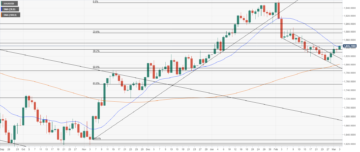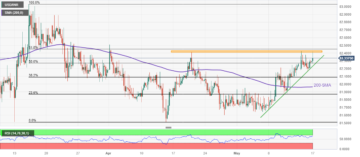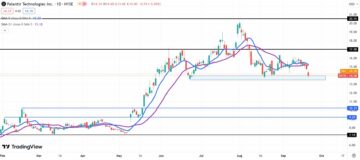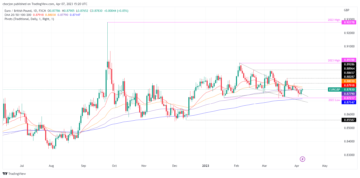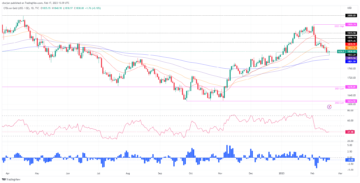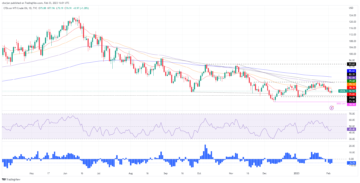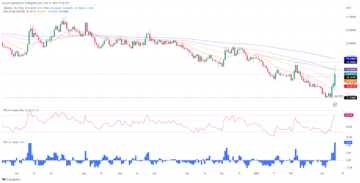
- The US JOLTS data will be watched closely by investors ahead of the Fed policy announcements.
- Job openings are forecast to edge lower to 8.75 million on the last business day of December.
- Further loosening in labor market conditions might not be enough to convince markets of a Fed rate cut in March.
The Job Openings and Labor Turnover Survey (JOLTS) will be released on Tuesday by the US Bureau of Labor Statistics (BLS). The publication will provide data about the change in the number of job openings in December, alongside the number of layoffs and quits.
JOLTS data will be scrutinized by market participants and Federal Reserve (Fed) policymakers because it could provide valuable insights regarding the supply-demand dynamics in the labor market, a key factor impacting salaries and inflation. While job openings have been trending down during 2023 – a sign of cooling demand for labor – they remain above pre-pandemic levels.
What to expect in the next JOLTS report?
“Over the month, the number of hires and total separations decreased to 5.5 million and 5.3 million, respectively,” the BLS noted in its November JOLTS report and added: “Within separations, quits (3.5 million) edged down and layoffs and discharges (1.5 million) changed little.”
After declining steadily from 10.5 million to 8.85 million in the January-October period, job openings edged lower to 8.79 million in November. For the upcoming December data, markets expect another slight down tick to 8.75 million. Meanwhile, Nonfarm Payrolls rose by 216,000 in December following November’s 170,000 increase.
The US Dollar (USD) started the new year on a bullish note. In January, the USD Index is up more than 2%, boosted by diminishing expectations for a Federal Reserve (Fed) rate reduction in March. According to the CME FedWatch Tool, the probability of a 25 basis points rate cut dropped from nearly 80% to 50%.
FXStreet Analyst Eren Sengezer shares his view on the JOLTS Job Openings data and the potential market reaction:
“JOLTS Job Openings data for December could reaffirm loosening conditions in labor market, unless it unexpectedly rises toward 9.5-10 million range. Investors, however, could refrain from taking a large position based on this data, especially hours before the Fed’s monetary policy announcements. Nevertheless, the immediate reaction to a significant surprise in either direction could be straightforward and remain short-lived. A decline below 8 million in job openings could hurt the USD, while a big increase could provide a boost to the currency”
When will the JOLTS report be released and how could it affect EUR/USD?
Job openings numbers will be published at 15:00 GMT. Eren points out key technical levels to watch for EUR/USD ahead of JOLTS data:
“The 200-day Simple Moving Average and the Fibonacci 38.2% retracement of the October-December uptrend form a pivot level at 1.0850 for EUR/USD. In case this level remains intact as resistance, the pair could test 1.0780 (100-day SMA) and 1.0700 (Fibonacci 61.8% retracement) next. On the upside, 1.0950 (Fibonacci 23.6% retracement) and 1.1000 (psychological level, static level) could be set as bullish targets in case the pair stabilizes above 1.0850.”
US Dollar FAQs
The US Dollar (USD) is the official currency of the United States of America, and the ‘de facto’ currency of a significant number of other countries where it is found in circulation alongside local notes. It is the most heavily traded currency in the world, accounting for over 88% of all global foreign exchange turnover, or an average of $6.6 trillion in transactions per day, according to data from 2022.
Following the second world war, the USD took over from the British Pound as the world’s reserve currency. For most of its history, the US Dollar was backed by Gold, until the Bretton Woods Agreement in 1971 when the Gold Standard went away.
The most important single factor impacting on the value of the US Dollar is monetary policy, which is shaped by the Federal Reserve (Fed). The Fed has two mandates: to achieve price stability (control inflation) and foster full employment. Its primary tool to achieve these two goals is by adjusting interest rates.
When prices are rising too quickly and inflation is above the Fed’s 2% target, the Fed will raise rates, which helps the USD value. When inflation falls below 2% or the Unemployment Rate is too high, the Fed may lower interest rates, which weighs on the Greenback.
In extreme situations, the Federal Reserve can also print more Dollars and enact quantitative easing (QE). QE is the process by which the Fed substantially increases the flow of credit in a stuck financial system.
It is a non-standard policy measure used when credit has dried up because banks will not lend to each other (out of the fear of counterparty default). It is a last resort when simply lowering interest rates is unlikely to achieve the necessary result. It was the Fed’s weapon of choice to combat the credit crunch that occurred during the Great Financial Crisis in 2008. It involves the Fed printing more Dollars and using them to buy US government bonds predominantly from financial institutions. QE usually leads to a weaker US Dollar.
Quantitative tightening (QT) is the reverse process whereby the Federal Reserve stops buying bonds from financial institutions and does not reinvest the principal from the bonds it holds maturing in new purchases. It is usually positive for the US Dollar.
- SEO Powered Content & PR Distribution. Get Amplified Today.
- PlatoData.Network Vertical Generative Ai. Empower Yourself. Access Here.
- PlatoAiStream. Web3 Intelligence. Knowledge Amplified. Access Here.
- PlatoESG. Carbon, CleanTech, Energy, Environment, Solar, Waste Management. Access Here.
- PlatoHealth. Biotech and Clinical Trials Intelligence. Access Here.
- Source: https://www.fxstreet.com/news/us-jolts-preview-job-openings-expected-to-edge-lower-in-december-extending-downtrend-202401300800
- :has
- :is
- :not
- :where
- $UP
- 000
- 1
- 10
- 15%
- 2%
- 2008
- 2022
- 2023
- 216
- 23
- 25
- 29
- 31
- 35%
- 36
- 40
- 75
- 8
- 9
- a
- About
- above
- According
- Accounting
- Achieve
- added
- adjusting
- affect
- Agreement
- ahead
- All
- alongside
- also
- america
- an
- analyst
- and
- Animate
- Announcements
- Another
- ARE
- AS
- At
- average
- away
- backed
- Banks
- based
- basis
- BE
- because
- been
- before
- below
- Big
- bis
- Bonds
- boost
- Boosted
- Bretton
- Bretton Woods
- British
- British Pound
- Bullish
- Bureau
- bureau of labor statistics
- business
- buy
- Buying
- by
- CAN
- case
- change
- changed
- choice
- Circulation
- closely
- CME
- COM
- combat
- conditions
- content
- control
- control inflation
- convince
- could
- Counterparty
- countries
- credit
- crisis
- crunch
- Currency
- Cut
- data
- day
- December
- Decline
- Declining
- decreased
- Default
- Demand
- diminishing
- direction
- does
- Dollar
- dollars
- down
- dropped
- during
- dynamics
- each
- easing
- Edge
- either
- employment
- ends
- enough
- especially
- Ether (ETH)
- EUR/USD
- exchange
- expanded
- expect
- expectations
- extreme
- factor
- Falls
- FAQ
- fear
- Fed
- Federal
- federal reserve
- Fibonacci
- financial
- financial crisis
- Financial institutions
- financial system
- flow
- following
- For
- Forecast
- foreign
- foreign exchange
- form
- Foster
- found
- from
- full
- Global
- GMT
- Goals
- Gold
- Gold Standard
- Government
- government bonds
- great
- Greenback
- Have
- heavily
- helps
- High
- hires
- his
- history
- holds
- HOURS
- How
- However
- HTTPS
- Hurt
- immediate
- impacting
- important
- in
- Increase
- Increases
- index
- inflation
- insights
- institutions
- interest
- Interest Rates
- Investors
- involves
- IT
- ITS
- January
- Job
- JOLTS Job Openings
- Key
- key factor
- labor
- labor market
- large
- Last
- layoffs
- Leads
- LEND
- Level
- levels
- likely
- little
- local
- lower
- lowering
- mandates
- March
- Market
- market conditions
- market reaction
- Markets
- May..
- Meanwhile
- measure
- might
- million
- module
- Monetary
- Monetary Policy
- Month
- more
- most
- moving
- moving average
- nearly
- necessary
- Nevertheless
- New
- new year
- next
- Nonfarm
- Nonfarm Payrolls
- note
- noted
- Notes
- November
- number
- numbers
- occurred
- of
- official
- on
- openings
- or
- Other
- out
- over
- pair
- participants
- Payrolls
- per
- period
- Pivot
- plato
- Plato Data Intelligence
- PlatoData
- points
- policy
- policymakers
- position
- positive
- potential
- pound
- predominantly
- price
- Prices
- primary
- Principal
- printing
- probability
- process
- provide
- psychological
- Publication
- published
- purchases
- QE
- QT
- quantitative
- Quantitative Easing
- quickly
- raise
- range
- Rate
- Rates
- reaction
- reaffirm
- reduction
- regarding
- reinvest
- released
- remain
- remains
- report
- Reserve
- Reserve Currency
- Resistance
- Resort
- result
- retracement
- reverse
- Rises
- rising
- ROSE
- salaries
- Second
- Second world war
- set
- shaped
- Shares
- sign
- significant
- Simple
- simply
- single
- situations
- SMA
- Stability
- standard
- started
- starts
- States
- static
- statistics
- steadily
- Stops
- straightforward
- substantially
- surprise
- Survey
- system
- taking
- Target
- targets
- Technical
- test
- than
- that
- The
- the Fed
- The United States of America
- the world
- Them
- These
- they
- this
- tick
- tightening
- to
- TONE
- too
- took
- tool
- Total
- toward
- traded
- Transactions
- trending
- Trillion
- Tuesday
- turnover
- two
- unemployment
- unemployment rate
- United
- United States
- UNITED STATES OF AMERICA
- unlikely
- until
- upcoming
- Upside
- uptrend
- us
- US Dollar
- us government
- USD
- USD value
- used
- using
- usually
- Valuable
- value
- View
- war
- was
- Watch
- weighs
- went
- when
- which
- while
- will
- within
- Woods
- world
- world’s
- year
- zephyrnet

